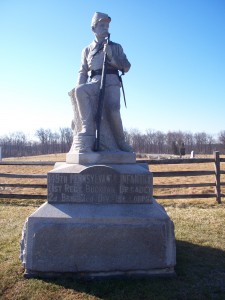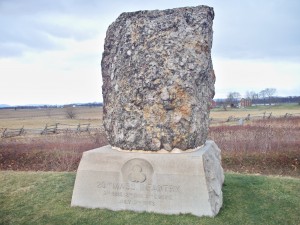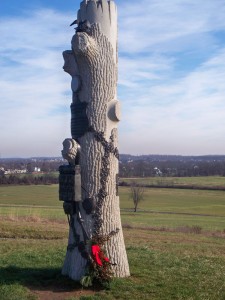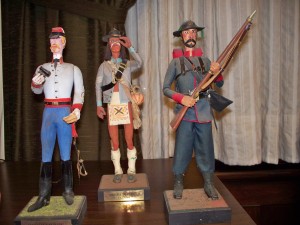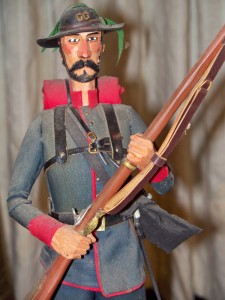Hike with Ike
May 11, 2012Hiking and storytelling have always gone hand-in-hand, so we know you’ll love this guided walking tour of downtown Gettysburg! And did we mention it’s free? Meet a Park Ranger at the Gettysburg College gates (the corner of North Washington and Water Streets) and prepare for an enthralling adventure! The hikes will be offered weekly on Thursdays at 7:15 PM, starting June 14th through August 16th.
Call 717-338-9114 or visit www.nps.gov/eise today for more information!
The Role of the Railroad in the Civil War
April 4, 2012It’s easy to take trains for granted in this day and age, so it’s important to remember that, in Civil War times, they were cutting edge. In fact, at the beginning of the War, we hadn’t quite figured out the military applications of the railroad beyond basic supply delivery. Although they had fewer tracks at their disposal, the Confederates were quicker to learn their value, using trains to speedily provide reinforcements that made the difference at battles like Bull Run. As the War progressed, both sides developed greater strategic dependence on the railroad as they realized its potential.
An army without supplies is not much of an army, so large forces typically stayed close to the tracks. This allowed them to protect the railways and trains, as well, since the newfound significance of the tracks made them targets for the enemy. A common practice was to plant pressure-sensitive “torpedoes” (essentially landmines) that would explode and derail the first train to roll over them. That led to precautionary tactics like sending an empty car ahead on the tracks. Trains were also susceptible to sharpshooters, who would try to puncture the boiler or take out the crew.
In spite of such weaknesses, locomotives were a powerful tool. You wouldn’t think of a train as a good scout vehicle, but a single engine could be sent on a reconnaissance mission into enemy territory, quickly reverse, and speed away at 60 mph. That might not seem like much to us, but it was fast enough to escape the cavalry that would pursue them. On top of that, they could be mounted with heavy artillery or loaded with riflemen, they could be used to ram enemy trains or set fire to their bridges, they could even be used as decoys to draw out concealed enemies. Trains were a true force to be reckoned with over the course of the Civil War.
We’ve barely scratched the surface of this fascinating subject—it’s really worth a visit to the Lincoln Train Museum to learn more!
The Bucktail Brigade 2.0
March 21, 2012In 1861, the 13th Pennsylvania Reserves made a name for themselves through both their gallantry and their skill as sharpshooters. It became their trademark to each wear a deer’s tail on their caps, as well as to mount one upon their flagstaff, which led them to be called the “Bucktail Brigade.” Their renown was such that the Secretary of War requested a second Bucktail Brigade from Colonel Roy Stone. Col. Stone was happy to oblige, and recruited twenty companies from ten counties in less than twenty days. They were organized into the 149th and 150th Regiments of the Pennsylvania Volunteer Infantry.
The 149th, or the “Second Bucktails,” were recruited in the summer of 1862 and were ordered to the front in early 1863. They first served in Chancellorsville, VA, before being advanced to Gettysburg.The regiment was positioned by Chambersburg Pike, on the ridge beyond the seminary, when the Confederates mounted a major assault. Colonel Stone was severely wounded and the entire Brigade was showered with heavy artillery fire. It was then that their color guard showed their true colors, so to speak, by moving their flags away from the fighting men and drawing the fire upon themselves. Their heroic sacrifice was a success, and the rest of the regiment was able to fall back to a better position.
A monument now stands in honor of the Second Bucktail Brigade, just off of Chambersburg Pike where they made their stand, near the McPherson Barn. The statue features a soldier who, if you follow his line of sight, gazes upon the spot where the valiant men of the color guard carried out their distraction. Out of 450 men engaged in the Battle, 53 were killed, 172 were injured, and 111 were missing, but the casualties would have been much worse if the flag-bearers hadn’t intervened. They are remembered as heroes.
The Battle of Gettysburg saw many examples of courage and heroism. Read more of them here.
The Full Package
February 19, 2012Our Packages are changing for the 2012 season:
The Value Plan will consist of choice of Bus Tour and 3 tickets for 3 museums out of the following 8 locations:
1.Hall of Presidents & First Ladies
2.Soldiers National Museum
3.The Jennie Wade House Museum
4.The Lincoln Train Museum
5.The Gettysburg Battle Theatre
6.The Gettysburg Diorama
7.The American Civil War Museum
8.David Wills House
Cost: Adults $42.00 Children (ages 6-12) $24.50. 5-7 hours to complete.
The Package Plan will consist of choice of Bus Tour and 5 tickets for 5 museums out of the following 8 locations:
1.Hall of Presidents & First Ladies
2.Soldiers National Museum
3.The Jennie Wade House Museum
4.The Lincoln Train Museum
5.The Gettysburg Battle Theatre
6.The Gettysburg Diorama
7.The American Civil War Museum
8.David Wills House
Cost: Adults $53.00 Children (ages 6-12) $30.00. 7-9 hours to complete.
Tickets in the Value Plan/Package Plan can be used throughout your stay, they do not need to be used all in one day.
Learn more!
Tips for Terrific Tours
February 9, 2012With winter waning, soon to succumb to spring, many of our attractions are making their final preparations to reopen for a brand new Gettysburg season. That makes now an excellent time to talk about the best ways to have a safe and happy visit. Take the following advice and you can make sure your vacation doesn’t turn into a National Lampoon Vacation!
As with any outdoor attraction, you must protect yourself from the elements! Nature can be outwitted if you prepare. First of all, hydrate. Make sure you drink plenty of water, especially in the summer. It’s also wise to know where and when you can use the restroom. Sunglasses, sunhats, and sun block can protect you from our solar friend. Be wary of poison ivy (leaves of three, let it be!) and other poisonous plant species. Always check yourself for ticks after you’ve been on a hike. And on the off chance that you encounter a snake, try not to surprise it. Emergency first aid is available; contact a park employee immediately.
It’s a good idea to purchase your tickets online and early: tours sell out and you don’t want to leave that to chance! Plan to arrive 15 minutes before the scheduled time of the tour and know that tours typically last about 2 hours. Remember to lock your car and keep valuables out of sight. Leave any backpacks and large bags in your vehicle or motel room, they will not be allowed in the Visitor Center. Cameras, however, are highly encouraged. Get some great shots and then send them to us!
Why wait? Reserve your tour now on our website!
The Bullet that Killed Jennie
February 5, 2012Period attire isn’t the only new thing at Jennie Wade House—2012 brings a new display that features the bullet Jennie was shot with. This unique piece of history packs a tragic tale into a tiny ball of metal.
Also, look for exciting new souvenirs in the gift shop! Our inventory grows every day!
The “Harvard Regiment”
February 2, 2012“Scarcely any Union regiment was in the heart of the storm longer than the Twentieth Massachusetts,” says History Today magazine. They weathered through nearly every battle of the Army of the Potomac, and a few others to boot. At Gettysburg, the men defended a pivotal position during Pickett’s Charge—an assault that, if successful, could have turned the tide of the Civil War. For all that they accomplished, the War took its toll on them: they suffered the highest casualties of any Massachusetts regiment and the fifth highest in the Union.
Known as “The Harvard Regiment,” the 20th Massachusetts Volunteer Infantry was formed in Roxbury, MA. All of the officers, and a portion of the enlisted men, were Harvard graduates, hence the nickname. The regiment was catapulted into battle in October, 1861, a mere month out of basic training; it was four years before they laid down their weapons at the end of the war. Among the Harvard men who served was Oliver Wendell Holmes Jr., who would go on to be nominated to the Supreme Court by Teddy Roosevelt and be remembered as one of the most influential Justices in American history.
One “celebrity” of the Harvard Regiment was Colonel Paul J Revere, who was killed in the Battle of Gettysburg. He was the grandson of his namesake, the midnight rider and patriot of the American Revolution. An unusual monument—a puddingstone boulder—was erected in memory of Revere and the 43 other men of his company who died at the Battle of Gettysburg. The 30-ton colossus, dedicated in 1886, was imported by train from Roxbury, where many of the soldiers grew up. Now, it can be visited on Hancock Avenue, near the immortalized “copse of trees” and the Confederate High Water Mark.
For more monuments that “rock,” click here and here!
The 90th Pennsylvania Infantry
January 4, 2012The battle-scarred skeleton of an oak tree marks the junction of Doubleday Avenue and Mummasburg Road in Gettysburg. From a distance, you might wonder why such a tree is left standing, why isn’t a lively sapling planted in its place? Only as you draw closer do you begin to realize that this forlorn tree is more than it appears…that it stands just a little too straight…that it, in reality, is a monument.
The 90th Pennsylvania Infantry is forever memorialized in the “Stalwart Oak Tree” just described, dedicated September 3, 1888. The sides are scorched, the limbs torn away, in an imitation of the artillery fire damage that claimed the lives of man and nature alike. Of the 208 men from the 90th who fought at Gettysburg, just 8 were killed, but 45 were wounded and 40 were missing. It doesn’t seem like a lot, on the grand scale, but that was 45% of their number.
Examine the Stalwart Oak with care—you’ll find, near the top, a nest with mother bird and hatchlings. Many have speculated over the meaning of this sculpted detail. There are two primary schools of thought: some believe it tells the story of a soldier under fire, risking his life to rescue the baby birds and their fallen nest; others postulate that the nest is symbolic, representing new life rising from the tatters of war, much like the Phoenix being reborn. Either way, the monument is a powerful testament that deserves to be revered.
What does the Stalwart Oak say to you? Read about another powerful monument here.
The Charley Weaver Display
December 24, 2011The Soldiers National Museum is bringing you a new display, featuring the works of the museum’s very own founder, Cliff Arquette! Of course, you probably know him better as Charley Weaver from The Tonight Show, but did you know he made wood carvings? The pride of Mamma and all of Mt. Idy will be available for your enjoyment, so come on down!
Learn more about Charley Weaver!
The Schoolteachers’ Regiment
December 14, 2011The 151st Pennsylvania Infantry was recruited from six different counties in the autumn of 1862. Many of the enlistees were educators who had laid down their grade books and left their classrooms to defend their families, students, and country. For that, they earned the nickname “The Schoolteacher’s Regiment.” Their orders carried them to DC and Virginia, where Confederates were disrupting the Union encampments with guerilla strikes. Soon after, they were reassigned to the Army of the Potomac and fought their first real battle at Chancellorsville, in Virginia.
A month away from discharge, the regiment moved on to Gettysburg, where Lieutenant Colonel George McFarland took temporary command. For the battle, they joined up with the Union defense of Seminary Ridge and McPherson’s Ridge on the left flank. The Confederate offensive was powerful, forcing one company to retreat and the rest to hide in the lee of a barricade. Gunsmoke completely obscured the soldiers’ vision, it was so thick on the field, but they maintained their defense.
McFarland was stooping down to see under the smoke and try to gain an advantage over the rebels, when a Confederate bullet pierced both of his legs. A heroic Private nearly died carrying him to the hospital—one of his brass buttons was severed by a bullet! The Lt. Col. was saved, while the rest of the regiment reformed and returned to battle on Cemetery Hill. In total, the Schoolteacher’s Regiment suffered 337 casualties of the 467 men present at Gettysburg. Their memorial stands at the intersection of Meredith and South Reynolds Avenues.
Read More about our fascinating monuments and the stories behind them!
